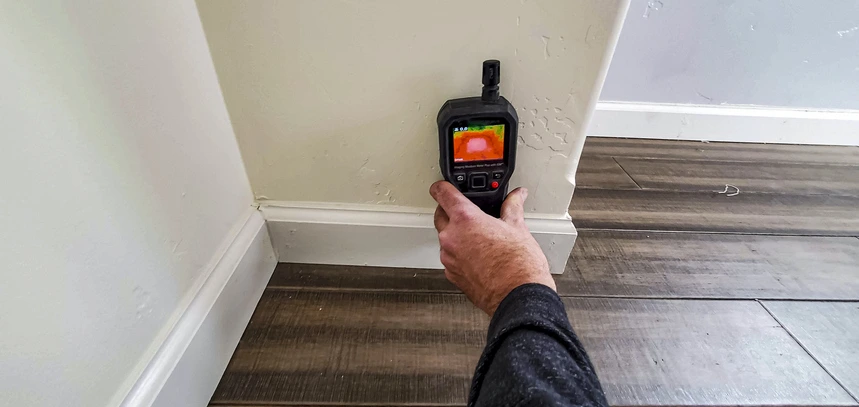
Maintaining a comfortable, healthy home environment involves more than adjusting the thermostat. Homeowners in North Central Arizona often notice that indoor air can feel dry in winter, heavy in summer, or inconsistent from room to room. While temperature is the most obvious factor, humidity and moisture content are just as important.
The science behind this interaction is called psychrometrics, which examines how air behaves with respect to moisture, energy, and temperature. Understanding psychrometrics can help you manage indoor comfort, improve air quality, and even reduce energy use.
All About Psychrometrics & Why It Matters
Psychrometrics is the study of air and water vapor mixtures, including their thermodynamic properties and how energy flows within them. For homeowners, the practical benefits are clear: managing air properly can prevent mold, improve comfort, and enhance HVAC efficiency.
Several key properties form the foundation of psychrometrics, including:
- Dry-Bulb Temperature (DBT). This is the temperature you measure with a regular thermometer, the value your thermostat shows.
- Relative Humidity (RH). RH represents the percentage of moisture in the air relative to the maximum it can hold at a given temperature, directly influencing comfort and health.
- Dew Point. When air cools to the dew point, water condenses, which can lead to window condensation or even mold growth.
- Enthalpy. This is the total energy in the air, including the heat you feel (sensible heat) and the energy stored in moisture (latent heat).
Each of these factors interacts in ways that affect how your home feels, how energy is used, and how efficiently your HVAC system operates.
How Temperature & Humidity Affect Indoor Air Quality
Even in Northern Arizona’s typically dry climate, humidity can have significant effects on indoor air quality. Let’s look at this in detail:
Comfort and Health
Too low or too high humidity can create discomfort and health concerns. Dry winter air can irritate skin, eyes, and sinuses, while overly humid summer air can make indoor spaces feel sticky and uncomfortable. Maintaining a relative humidity between 40 and 50 percent can improve comfort, reduce static electricity, and protect wooden furniture.
Proper humidity also protects health. Low humidity can exacerbate respiratory issues, while high humidity encourages mold and dust mites. Understanding these relationships helps homeowners proactively manage their indoor environment.
HVAC Efficiency
Temperature and moisture are closely tied to how your heating and cooling system performs, influencing comfort and energy use throughout the year.
These dynamics can create challenges if not properly managed:
- Air with higher moisture content requires more energy to cool, because the HVAC system must remove both heat and latent moisture.
- Extremely dry air can feel cooler, which may cause your heating system to work harder during the winter months.
- Factoring in humidity allows your HVAC system to maintain comfortable conditions more efficiently, balancing temperature and moisture for consistent indoor comfort.
By understanding these relationships, homeowners can make smarter decisions about system settings, maintenance, and upgrades, ultimately creating a more comfortable and energy-efficient home environment.
Applying Psychrometrics to Your Arizona Home
Modern HVAC systems use psychrometric principles to balance temperature and humidity for maximum comfort and efficiency.
Winter Dryness
During Northern Arizona winters, indoor humidity often drops below 20 percent, leading to discomfort and dry air symptoms.
Homeowners can improve conditions by:
- Installing a whole-home humidifier to maintain 40–50 percent relative humidity.
- Sealing windows and doors to prevent infiltration of cold, dry outdoor air.
- Adjusting thermostat settings to maintain warmth without overusing the furnace.
Summer Heat & Humidity
Even in a dry desert climate, summer humidity spikes can occur.
Managing moisture during cooling season helps reduce discomfort and energy costs:
- Fine-tuning your air conditioning system ensures it removes sufficient moisture without overcooling the home.
- Optimizing ventilation introduces fresh air strategically to lower indoor moisture levels.
- Inspecting and maintaining ductwork prevents unwanted humid air from entering your system.
Seasonal Transitions
Spring and fall bring fluctuating temperatures and humidity. These shifts can result in condensation on windows, uneven heating or cooling, and dust accumulation.
Homeowners can respond by:
- Adjusting HVAC operation based on indoor and outdoor conditions.
- Monitoring relative humidity and making minor adjustments with portable or whole-home devices.
- Scheduling air filter replacement and HVAC inspections to maintain system efficiency.
Advanced HVAC Strategies Using Psychrometrics
Understanding psychrometrics can unlock advanced comfort and efficiency solutions in your home.
We recommend prioritizing:
- Zoning & Room-by-Room Control. Smart thermostats use temperature and humidity data to balance conditions across different rooms, ensuring each space remains comfortable without wasting energy.
- Air Filtration & Purification. HEPA or electrostatic filters remove allergens and particulates, but they work best when humidity is balanced—too much moisture can reduce effectiveness.
- Energy Efficiency. Psychrometric principles allow systems to calculate total heat content (enthalpy) in air, optimizing energy use while maintaining comfort.
By integrating these strategies, homeowners can maintain consistent indoor conditions, reduce energy costs, and protect their HVAC investment.
Practical Psychrometric Tips for Homeowners
Applying psychrometrics at home doesn’t require technical expertise.
Here are some practical steps:
- Monitor indoor humidity with digital hygrometers placed in multiple rooms.
- Seal leaks around doors and windows to prevent unwanted airflow and moisture fluctuations.
- Use humidifiers or dehumidifiers to maintain optimal relative humidity.
- Schedule regular HVAC maintenance to keep coils, ducts, and filters clean.
- Upgrade thermostats to smart systems that manage both temperature and humidity automatically.
- Ventilate strategically to balance indoor air without excessive energy use.
These small, intentional steps help homeowners improve comfort, reduce illness risk, and increase HVAC efficiency.
Psychrometrics Across Different Home Types
Single-Family Homes
Smaller volumes of air make humidity easier to control, but homeowners still need to monitor temperature and moisture balance. Centralized HVAC systems usually perform well with minor adjustments.
Multi-Story or Open Floor Plans
Humidity and temperature can vary significantly between levels or open spaces. Zoning and airflow balancing become essential for maintaining psychrometric equilibrium.
High-Tech & Smart Homes
Smart homes can use sensors and AI-driven HVAC controls to respond dynamically to changes in temperature and humidity, preemptively addressing discomfort and reducing energy waste.
Optimize Your Indoor Environment with Science-Backed HVAC Strategies
At Aire Serv of North Central Arizona, we apply psychrometric principles to help homeowners achieve optimal indoor air quality, comfort, and energy efficiency.
Our services include:
- HVAC Tune-Ups & Inspections. We’ll ensure your system balances temperature and humidity effectively.
- Indoor Air Quality Solutions. We can install and maintain humidifiers, dehumidifiers, and purification systems tailored to your home.
- Energy Efficiency Upgrades. Our team can help you set up smart thermostats, improve zoning, and optimize ductwork.
- Preventive Maintenance. Professional HVAC tune-ups, inspections, and system adjustments maintain comfort and health throughout the year.
By combining science-backed strategies with expert HVAC service, we help homeowners reduce energy costs, improve indoor air quality, and maintain year-round comfort.Understanding psychrometrics provides homeowners with the knowledge to manage temperature, humidity, and indoor air quality effectively. From preventing dry winter air to controlling summer moisture, applying these principles ensures your home remains comfortable, healthy, and energy-efficient.
At Aire Serv of North Central Arizona, our team can evaluate your home’s HVAC system, recommend targeted improvements, and implement solutions to enhance comfort, indoor air quality, and efficiency.
Looking to optimize their HVAC system with psychrometric-informed solutions? Call or contact us online today.

